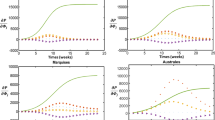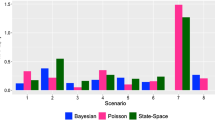Abstract
The Zika virus (ZIKV) epidemic has caused an ongoing threat to global health security and spurred new investigations of the virus. Use of epidemiological models for arbovirus diseases can be a powerful tool to assist in prevention and control of the emerging disease. In this article, we introduce six models of ZIKV, beginning with a general vector-borne model and gradually including different transmission routes of ZIKV. These epidemiological models use various combinations of disease transmission (vector and direct) and infectious classes (asymptomatic and pregnant), with addition to loss of immunity being included. The disease-induced death rate is omitted from the models. We test the structural and practical identifiability of the models to find whether unknown model parameters can uniquely be determined. The models were fit to obtain time-series data of cumulative incidences and pregnant infections from the Florida Department of Health Daily Zika Update Reports. The average relative estimation errors (AREs) were computed from the Monte Carlo simulations to further analyze the identifiability of the models. We show that direct transmission rates are not practically identifiable; however, fixed recovery rates improve identifiability overall. We found ARE is low for each model (only slightly higher for those that account for a pregnant class) and help to confirm a reproduction number greater than one at the start of the Florida epidemic. Basic reproduction number, \(\mathcal {R}_0\), is an epidemiologically important threshold value which gives the number of secondary cases generated by one infected individual in a totally susceptible population in duration of infectiousness. Elasticity of the reproduction numbers suggests that the mosquito-to-human ratio, mosquito life span and biting rate have the greatest potential for reducing the reproduction number of Zika, and therefore, corresponding control measures need to be focused on.


Similar content being viewed by others
Notes
References
Baca-Carrasco D, Velasco-Hernandez JX (2016) Sex, mosquitoes and epidemics: an evaluation of Zika disease dynamics. Bull Math Biol 78(11):2228–2242
Banks HT, Hu S, Thompson WC (2014) Modeling and inverse problems in the presence of uncertainty. CRC Press, Boca Raton
Bellu G, Saccomani MP, Audoly S, D’Angio L (2007) DAISY: a new software tool to test global identifiability of biological and physiological systems. Comput Methods Programs Biomed 88(1):52–61
Castillo-Chavez C, Song B (2004) Dynamical models of tuberculosis and their applications. Math Biosci Eng 1(2):361–404
CDC (2016) Estimated range of Aedes albopictus and Aedes aegypti in the United States. https://www.cdc.gov/zika/vector/range.html
Chis OT, Banga JR, Balsa-Canto E (2011) Structural identifiability of systems biology models: a critical comparison of methods. PLoS ONE 6(11):e27755
Chitnis N, Hyman JM, Manore CA (2013) Modelling vertical transmission in vector-borne diseases with applications to Rift Valley fever. J Biol Dyn 7(1):11–40
Chowell G, Hincapie-Palacio D, Ospina J et al (2016) Using phenomenological models to characterize transmissibility and forecast patterns and final burden of Zika epidemics. PLoS Curr Outbreaks. https://doi.org/10.1371/currents.outbreaks.f14b2217c902f453d9320a43a35b9583
Dick GW, Kitchen SF, Haddow AJ (1952) Zika virus. I. Isolations and serological specificity. Trans R Soc Trop Med Hyg 46:509520
Driggers RW, Ho CY, Korhonen EM et al (2016) Zika virus infection with prolonged maternal viremia and fetal brain abnormalities. N Engl J Med 374:2142
Dudley DM, Aliota MT et al (2016) A rhesus macaque model of Asian-lineage Zika virus infection. Nat Commun 7:12204
Faye O, Freire CCM et al (2014) Molecular evolution of Zika Virus during its emergence in the 20th century. PLOS Negl Trop Dis 8(1):e2636
Gao D, Lou Y et al (2016) Prevention and control of Zika as a Mosquito-Borne and sexually transmitted disease: a mathematical modeling analysis. Sci Rep 6, Article number: 28070
Karlson J, Anguelova M, Jirstrand M (2012) An efficient method for structural identifiability analysis of large dynamic systems. In: 16th IFAC Symposium on System Identification, The international Federation of Automatic Control, Brussels, Belgium, 11–13 July 2012
Kindhauser MK, Allen T, Frank V, Santhana R, Dye C (2016) Zika: the origin and spread of a mosquito-borne virus. Bull World Health Organ. https://doi.org/10.2471/BLT.16.171082
Kucharski AJ et al (2016) Transmission dynamics of Zika virus in island populations: a modelling analysis of the 2013–14 French Polynesia outbreak. PLoS Negl Trop Dis. https://doi.org/10.1371/journal.pntd.0004726
Lanciotti RS, Lambert AJ, Holodniy M, Saavedra S, del Carmen L, Signor C (2016) Phylogeny of Zika virus in western hemisphere, 2015. Emerg Infect Dis 22(5):933935
Martcheva M (2015) An introduction to mathematical epidemiology. Springer, New York
Meshkat N, Kuo CE, DiStefano J III (2014) On finding and using identifiable parameter combinations in nonlinear dynamic systems biology models and COMBOS: a novel web implementation. PLoS ONE 9(10):e110261
Miao H, Xia X, Perelson AS, Wu H (2011) On identifiability of nonlinear ODE models and applications in viral dynamics. SIAM Rev 53(1):3–39
Mlakar J, Korva M, Tul N et al (2016) Zika virus associated with microcephaly. N Engl J Med 374:951
Osuna CE, Lim S-Y (2016) Zika viral dynamics and shedding in rhesus and cynomolgus macaques. Nat Med 22(12):1448–1455
Perkins TA, Siraj AS, Ruktanonchai CW, Kraemer MUG, Tatem AJ (2016) Model-based projections of Zika virus infections in childbearing women in the Americas. Nat Microbiol 1(9):16126
Petersen EE, Staples JE, Meaney-Delman D, Fischer M, Ellington SR, Callaghan WM, Jamieson DJ (2016) Interim guidelines for pregnant women during a Zika virus outbreak United States, 2016, CDC, MMWR. http://www.cdc.gov/mmwr/volumes/65/wr/mm6502e1.htm
Population (2016) http://population2016.com/population-of-florida-in-2016.html
Raue A et al (2009) Structural and practical identifiability analysis of partially observed dynamical models by exploiting the profile likelihood. Bioinformatics 25(15):1923–1929
Smith DL, Battle KE, Hay SI, Barker CM, Scott TW, McKenzie FE (2012) Ross, Macdonald, and a theory for the dynamics and control of mosquito-transmitted pathogens. PLoS Pathogens 8(4):e1002588
Stigter JD, Molenaar J (2015) A fast algorithm to assess local structural identifiability. Automatica 58:118–124
Tuncer N, Gulbudak H, Cannataro VL, Martcheva M (2016) Structural and practical identifiability issues of immuno-epidemiological vector–host models with application to Rift Valley Fever. Bull Math Biol 78:1796–1827
Velasco-Hernandez JX (1994) A models for Chagas disease involving transmission by vectors and blood transfusions. Theor Popul Biol 46:1–31
Villaverde AF et al (2016) Structural identifiability of dynamic systems biology models. PLOS Comput Biol 12(10):e1005153
Wei HM, Li XZ, Martcheva M (2008) An epidemic model of a vector-borne disease with direct transmission and time delay. J Math Anal Appl 342(2):895–908
WHO, One year into the Zika outbreak: how an obscure disease became a global health emergency. http://www.who.int/emergencies/zika-virus/articles/one-year-outbreak/en/index1.html
Wu KY, Zuo GL et al (2016) Vertical transmission of Zika virus targeting the radial glial cells affects cortex development of offspring mice. Cell Res 26:645654. https://doi.org/10.1038/cr.2016.58
Yang H, Wei H, Li X (2010) Global stability of an epidemic model for vector-borne disease. J Syst Sci Complex 23:279–292
Author information
Authors and Affiliations
Corresponding author
Appendix
Appendix
Here, we prove Theorem 1.
Proof
Let \(\xi _p = 0\). We assume that \(\gamma \ge \gamma _p\). The case \(\gamma <\gamma _p\) is similar. We express all variables in terms of \(i+i_p\) where \(i=I/N\) and \(i_p=I_p/N\)
We solve for \(s = S/N\):
Substituting in the equation for i and solving for i, we have
where
It is not hard to show that \(i>0\). Replacing i from the above expression in s, we can obtain s in terms of \(i+i_p\).
We express \(s_p\) in terms of \(i+i_p\):
From here, we obtain \(i_p\) in terms of \(i+i_p\):
Substituting in \(i+i_p\) and canceling \(i+i_p\), we obtain the following equation for \(i+i_p\):
It is not hard to see that if \(\omega =0\), the right-hand side of the above equality is a decreasing function of \(i+i_p\) that does not depend of \(\gamma -\gamma _p\). Hence, in the case \(\omega =0\), if the above equation has a solution, it must be unique. In the general case to see that the above equation has a solution, notice that \(G(0)+\mathcal K(0)=\mathcal R_{05}>1\). Next, we show that \(G(1)+\mathcal K(1)<1\). Some computation shows that
Furthermore,
This gives the estimate
Hence,
We conclude that in the case \(\mathcal R_{05}>1\) there must be at least one solution. \(\square \)
Now we prove Theorem 2.
Proof
We apply Theorem 4.1 in Castillo-Chavez and Song (2004). We denote by \(f_1,\dots , f_6\) the right-hand sides of Eq. (7) with variables ordered the same way as the equations. We use \(\beta \) as a bifurcation parameter in place of \(\phi \) in Theorem 4.1. It is not hard to show that if \(\beta =\beta ^*\) where \(\beta ^*\) is the value that makes \(\mathcal R_{05}=1\), the Jacobian of the system has a unique zero eigenvalue and all other eigenvalues have negative real parts. We compute the right eigenvector to obtain:
Next, we compute the left eigenvector which has the following nonzero components:
Since only \(v_2, v_3, v_6\) are nonzero, we need the partial derivatives of \(f_3, f_4\) and \(f_6\). They are not hard to compute:
In addition, the only right-hand side in (21) that has nonzero derivative with respect to \(\beta \) is \(f_6\). Hence, we have
From here, \(b= v_6 m(w_3+w_4)>0\). Thus, the direction of the bifurcation is controlled by a and is a backward bifurcation if and only if \(a>0\) where
which gives the condition in the statement of the theorem. This concludes the proof. \(\square \)
Rights and permissions
About this article
Cite this article
Tuncer, N., Marctheva, M., LaBarre, B. et al. Structural and Practical Identifiability Analysis of Zika Epidemiological Models. Bull Math Biol 80, 2209–2241 (2018). https://doi.org/10.1007/s11538-018-0453-z
Received:
Accepted:
Published:
Issue Date:
DOI: https://doi.org/10.1007/s11538-018-0453-z




